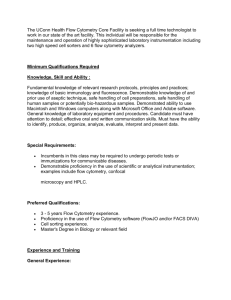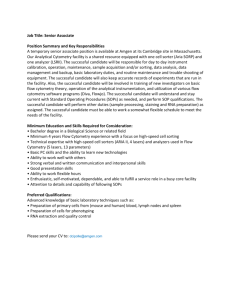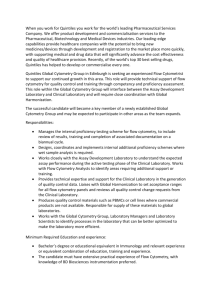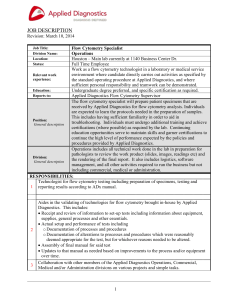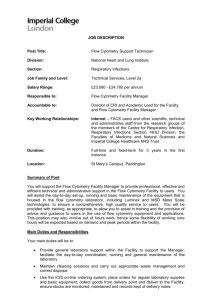biology 255m - Biological Sciences
advertisement
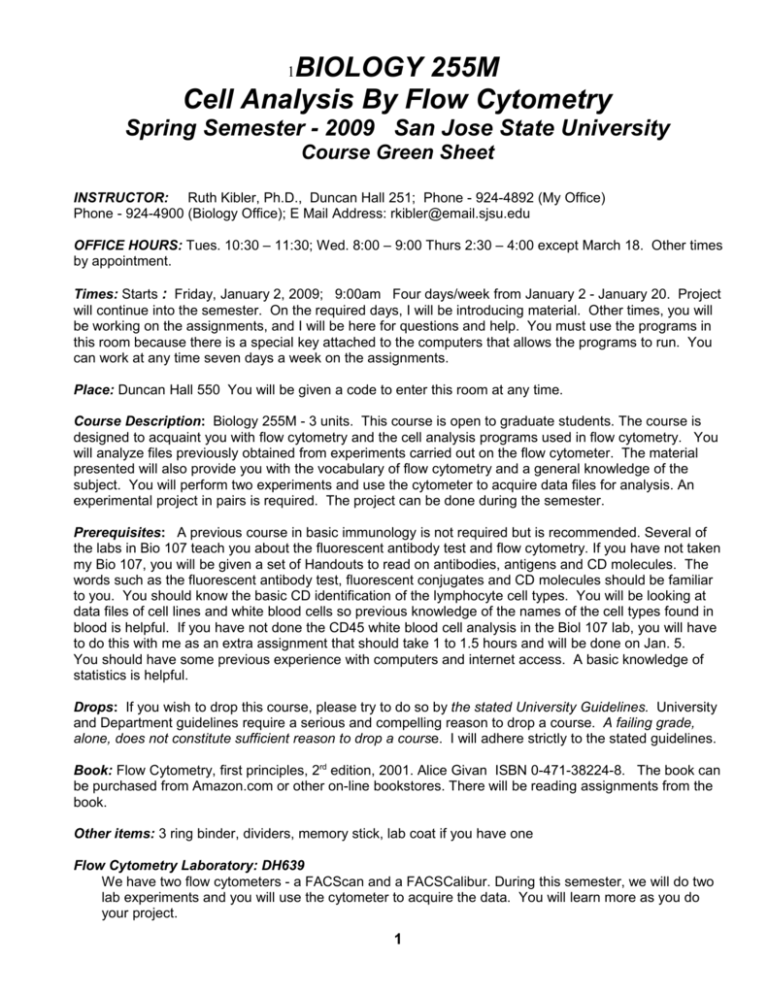
BIOLOGY 255M Cell Analysis By Flow Cytometry 1 Spring Semester - 2009 San Jose State University Course Green Sheet INSTRUCTOR: Ruth Kibler, Ph.D., Duncan Hall 251; Phone - 924-4892 (My Office) Phone - 924-4900 (Biology Office); E Mail Address: rkibler@email.sjsu.edu OFFICE HOURS: Tues. 10:30 – 11:30; Wed. 8:00 – 9:00 Thurs 2:30 – 4:00 except March 18. Other times by appointment. Times: Starts : Friday, January 2, 2009; 9:00am Four days/week from January 2 - January 20. Project will continue into the semester. On the required days, I will be introducing material. Other times, you will be working on the assignments, and I will be here for questions and help. You must use the programs in this room because there is a special key attached to the computers that allows the programs to run. You can work at any time seven days a week on the assignments. Place: Duncan Hall 550 You will be given a code to enter this room at any time. Course Description: Biology 255M - 3 units. This course is open to graduate students. The course is designed to acquaint you with flow cytometry and the cell analysis programs used in flow cytometry. You will analyze files previously obtained from experiments carried out on the flow cytometer. The material presented will also provide you with the vocabulary of flow cytometry and a general knowledge of the subject. You will perform two experiments and use the cytometer to acquire data files for analysis. An experimental project in pairs is required. The project can be done during the semester. Prerequisites: A previous course in basic immunology is not required but is recommended. Several of the labs in Bio 107 teach you about the fluorescent antibody test and flow cytometry. If you have not taken my Bio 107, you will be given a set of Handouts to read on antibodies, antigens and CD molecules. The words such as the fluorescent antibody test, fluorescent conjugates and CD molecules should be familiar to you. You should know the basic CD identification of the lymphocyte cell types. You will be looking at data files of cell lines and white blood cells so previous knowledge of the names of the cell types found in blood is helpful. If you have not done the CD45 white blood cell analysis in the Biol 107 lab, you will have to do this with me as an extra assignment that should take 1 to 1.5 hours and will be done on Jan. 5. You should have some previous experience with computers and internet access. A basic knowledge of statistics is helpful. Drops: If you wish to drop this course, please try to do so by the stated University Guidelines. University and Department guidelines require a serious and compelling reason to drop a course. A failing grade, alone, does not constitute sufficient reason to drop a course. I will adhere strictly to the stated guidelines. Book: Flow Cytometry, first principles, 2rd edition, 2001. Alice Givan ISBN 0-471-38224-8. The book can be purchased from Amazon.com or other on-line bookstores. There will be reading assignments from the book. Other items: 3 ring binder, dividers, memory stick, lab coat if you have one Flow Cytometry Laboratory: DH639 We have two flow cytometers - a FACScan and a FACSCalibur. During this semester, we will do two lab experiments and you will use the cytometer to acquire the data. You will learn more as you do your project. 1 Analysis Programs: There are two cell analysis programs on the computers in DH550. CellQuest runs in the MAC OS9 or Classic OS9 format. COLORCell runs on Macs with OS10 and on PCs with JAVA. CellQuestTM is a commercial program sold by BD Biosciences, Immunocytometry Systems (BDIS). The program was purchased from BDIS through a grant from the California Lottery Funds. This program can only be used on Macintosh computers that have a “key” (also known as a dongle) which unlocks the program. You must learn this program because it is used on many of the cytometers in research and clinical laboratories. Knowing this program has helped some students obtain employment after completing their degree. COLORCell is a program written by a San Jose State University student though a National Science Foundation grant to John Boothby and Ruthann Kibler as well as help or funding through CSUPERB and BD Biosciences. The program is free for educational use only and will work on both MACS (OS10) and PCs with JAVA. You may copy the program to your computer. If you must do some analysis at home you can do it with this program, but since you will be tested on your ability to use CellQuest, you must do most of your work with that program. A first draft of the instruction manual for COLORCell is also available. It is not finished. WINMidi is a freeware program for PCs that is somewhat similar to CellQuest. To download this program, go to www.cyto.purdue.edu. Click on software and look for WINMidi. Other Programs: Word, PowerPoint and Excel are available in OS10. You can bring plots from CellQuest into Word and PowerPoint using the Mac copy/paste functions. You will be able to save from these programs to your Home folder that is accessible only to your number and password. You can save your work on a memory stick also. Assignments: You will be given assignments which you can complete during the assigned class time or any other time since you will have code access to DH550. Most of the assignments must be completed during the 2.5 weeks of the January part of the course. A project conducted in pairs will be completed during the semester. Laboratory Experiments Tuesday January 6 Immunophenotyping or CD34 stem cells Both topics will be introduced Friday morning. After the introduction (probably after lunch), students without Bio107 will carry out the immunophenotyping experiment. Student who have completed the Bio 107 lab will do the CD34 experiment. January 12 morning: DNA of plants Analysis of Experimental Data will include: Designing experiments from the information given to you. Your design will include such headings as Purpose Materials and Methods Answering Questions Analyzing the data Describing results Writing a discussion or conclusion Project: You will do this in pairs during the semester. This does not have to be an extensive project. The purpose of this is really to give you more time on the cytometer. You will propose the project/question, write up an introduction, materials and methods, use the cytometer to acquire the data, analyze the files, write the results and discussion in journal format. Turn in the written assignment by the end of April. We will discuss this further in class. The results could also be made in poster format instead of journal format. 2 Approximate idea of assignments and points - this can change somewhat. Assign ment Vocab Ex1 Beads Ex2 Tut CellQ Ex3 ImPhen Ex4 CD34 Ex5 ? Ex6 DNA Ex7 L&L Ex8 ? Exam Project Points 5 10 10 45 55 30 55 30 30 75 60 *Students who did not take my immunology lab: There will be one assignment for no points that those students who did not take my immunology lab must do. It will take about 1.5 hrs and I will do it with you if possible - This is the CD45 assignment. If you took the immunology lab, review the CD45 pattern of WBC or do the assignment with the students as a review. We need to arrange a time - We must do this on Monday, Jan. 5 – time to be arranged Grading: Assignments will be turned in and graded. The type of sheet that I use to grade each assignment is attached to this Greensheet. There will be seven or eight assignments plus the final and the project. This is a graduate course so I expect grades of A or B. The grading will be curved once all totals for the course assignments are present. I use A, A-, B+, B, B-. I hope I do not have to use a C or less. Exam: There will one exam on Jan. 20. The exam will be both an in-class and take home. The inclass part will be analysis of a problem/files using CellQuest. The take home part will continue this analysis. Very Tentative Schedule: Week 1 I am guessing the times and they will vary depending on how fast you do the analysis and how much time you have during the “free time”. I would suggest bringing a lunch most of the days. Coffee and assorted teas provided. Jan 2 5 to 6 hrs Friday or Saturday Introduction to the computer room Introduction to flow ctyometry - BD tutorial and vocabulary Exercise 1 Beads Introduction of COLORCell Program Exercise 2 CellQuest tutorial to learn the program - introduction of program You will start working on the CellQuest tutorial in DH550 while two to four students go to the flow cytometry room and start Exercise 1. Jan. 5 3 to 5 hrs. Monday (CD45 exercise for those who did not take Bio 107 lab – probably at 8 am) Continue or start CellQuest Tutorial or analysis of Exercise 1 Groups of four students will go to the flow cytometry room to learn to use the cytometer using Exercise 1. Jan. 6 ~6 hrs Tuesday Due on this day. Vocabulary, Ex 1 and Ex 2. (probably) Intro to the laboratory - Im. Phenotyping and CD34 stem cell analysis Laboratory Experiments, acquisition of data files; can start analysis 3 Jan. 7 Jan. 8 Wednesday Submit Exercises 1 and 2. Intro and analysis of CD34 stem cells files. Logical gating and rare events. Analysis of immunophenotyping files continues. Thursday Free time to work on assignments. I will be here most of the day if you need help. Jan. 9 Week 2 Jan 12 Jan. 13 Jan. 14 Jan. 15 Jan. 16 Jan 19 Jan. 20 Friday In class analysis of an experiment – HLA – DR and Sepsis probably DNA experiment, introduction, acquisition, how to analyze, start analysis ~5 hrs Turn in immunophenotyping and CD34 assignments.Free time to work on assignments. I will be here most of the day if you need help. Discuss projects. Show tetrahymena system. Analysis of DNA files Turn in HLA-DR/Sepsis exercise Leukemia and lymphoma analysis - in class analysis Free day to work on assignments. In class analysis of either tetrahymena or a new exercise. Submit DNA and Leukemia exercises. Holiday Exam - This will be an analysis - part in class and part take home. Acknowledgments: Thanks go to the following individuals Maria Quist - Former BDIS employee. Many of the files and the ideas for the experiments are the results of work by Maria or Valerie (under Maria’s supervision). Valerie Rubio - Former SJSU student and summer intern at BDIS; presently an employee of BDIS as a trainer. Her experimental results are found in some of the files you will use. Meg Reilly - Former BDIS employee. Use of her laboratory for the experiments carried out by Valerie and myself, many helpful suggestions Betty Eastham, Nancy Isaac, Diane Ward, Maria Quist, and Cindy Marrow - all former BDIS employees for their help in numerous endeavors. Cheri Wagner - BDIS for help on in obtaining materials for class; Dieter Recktenwald - BDIS for help on the ColorCell Program. Thomas Yan - former SJSU student and present Santa Clara University graduate student for writing the ColorCell Program. Web Sites for Flow Cytometry www.cyto.purdue.edu/flowcyt/software/Spectra.htm Fluorescence Spectra Viewer Interactive way to look at the spectra of various fluorescent dyes www.bdfacs.com Becton-Dickinson Biosciences (BD Biosciences) BD Immunocytometry Systems (BDIS) web site. Lots of info on protocols, cytometers and monoclonal antibodies Tutorial on Flow Cytometry – BD Biosciences, San Jose, CA www.bdbiosciences.com/immunocytometry_systems/support/training/online/ITF/start.html www.sciencegateway.org/ Try this site. It is an interesting resource and will get you to PROW. www.ncbi.nih.nlm.gov/prow/ Protein Resources on the Web (PROW) Type in the CD and the site takes 4 you to information on the molecule as well as which cells have the molecule. This seems to be a government sponsored site through the National Institutes of Health (NIH) and the National Library of Medicine (NLM). www.cyto.purdue.edu/index.htm A good site with links to most or all other flow cytometry sites. www.pingu.salk.edu/ Click on flow cytometry on the web to see a lot of other sites. www.bioech.ufl.edu/~fccl/flow_edu.html Click on Flow and Analysis of DNA. Explains histogram of the cell cycle. Invitrogen Flow Tutorials and SpectraViewer www.invitrogen.com/site/us/en/home/support/Tutorials.reg.us.html www.invitrogen.com/site/us/en/home/support/Research-Tools/FluorescenceSpectraViewer.reg.us.html?fileld1=21422p72 Catalogs www.probes.com This is the site for Invitrogen/molecular probes and the Handbook is excellent for fluorescent dyes Books: These are only a few of the books available. Flow Cytometry, (Practical Approach Series), Michael Ormerod, ed., Oxford Press, 2000 Flow Cytometry, First Principles, Alice Longobardi Givan, 2001 Current Protocols in Cytometry, published by John Wiley and Sons in affiliation with the International Society for Analytical Cytology (ISAC) Practical Flow Cytometry, Shapiro, 4th edition. University, College, or Department Policy Information Academic Integrity Statement “Your own commitment to learning, as evidenced by your enrollment at San Jose State University, and University’s Integrity Policy, require you to be honest in all of your academic course work. Faculty members are required to report all infractions to the office of Judicial Affairs. The policy on academic integrity can be found at: http://sa.sjsu.edu/judicial_affairs/index.html” Campus policy in compliance with the Americans with Disabilities Act “If you need course adaptations or accommodations because of a disability, or if you need special arrangements in case the building must be evacuated, please make an appointment with me as soon as possible, or see me during office hours. Presidential Directive 97-03 requires that students with disabilities requesting accommodations must register with DRC to establish a record of their disability.” Department Policy on Repeating Classes Students will be allowed to repeat biology majors= classes ONLY ONCE. This includes repeating classes for Academic Renewal and repeating them at other institutions. Note that 5 failure to successfully complete a required major’s class in the second attempt may result in disqualification from the major. Department Policy on Late Adds The Department of Biological Sciences does not approve Late Adds (adding classes after the end of the add period indicated in the schedule and directory). You are responsible for adding classes before the last day to add and for confirming via Touchtone that you are in the class. When your instructor gives you an add code, you should use it immediately to avoid problems. Course Objectives General Objectives – you will be able to: Describe the principles of flow cytometry – fluidics, optics, electronics Define flow cytometry terms Explain how data is analyzed Explain the meaning of flow cytometry plots Cytometers – FACSCalibur and FACScan Lean how to use an analytic flow cytometer at a basic user level (Includes set up, acquiring data files, shut down) Practice using the cytometer through three lab exercises and a project Analysis of Data Learn the commercial program, CellQuestTM You should be comfortable using this program by the end of the course. Analyze previously acquired data files using CellQuest. Analyze your data files using CellQuest Learn the program ColorCell (Academic use only) Copywrite San Jose State University Laboratory Exercises Learn to set up the cytometry using fluorescent beads Perform 3 color stain of cells for immunophenotyping Perform DNA cell cycle and ploidy experiment using etiolated plants 6
